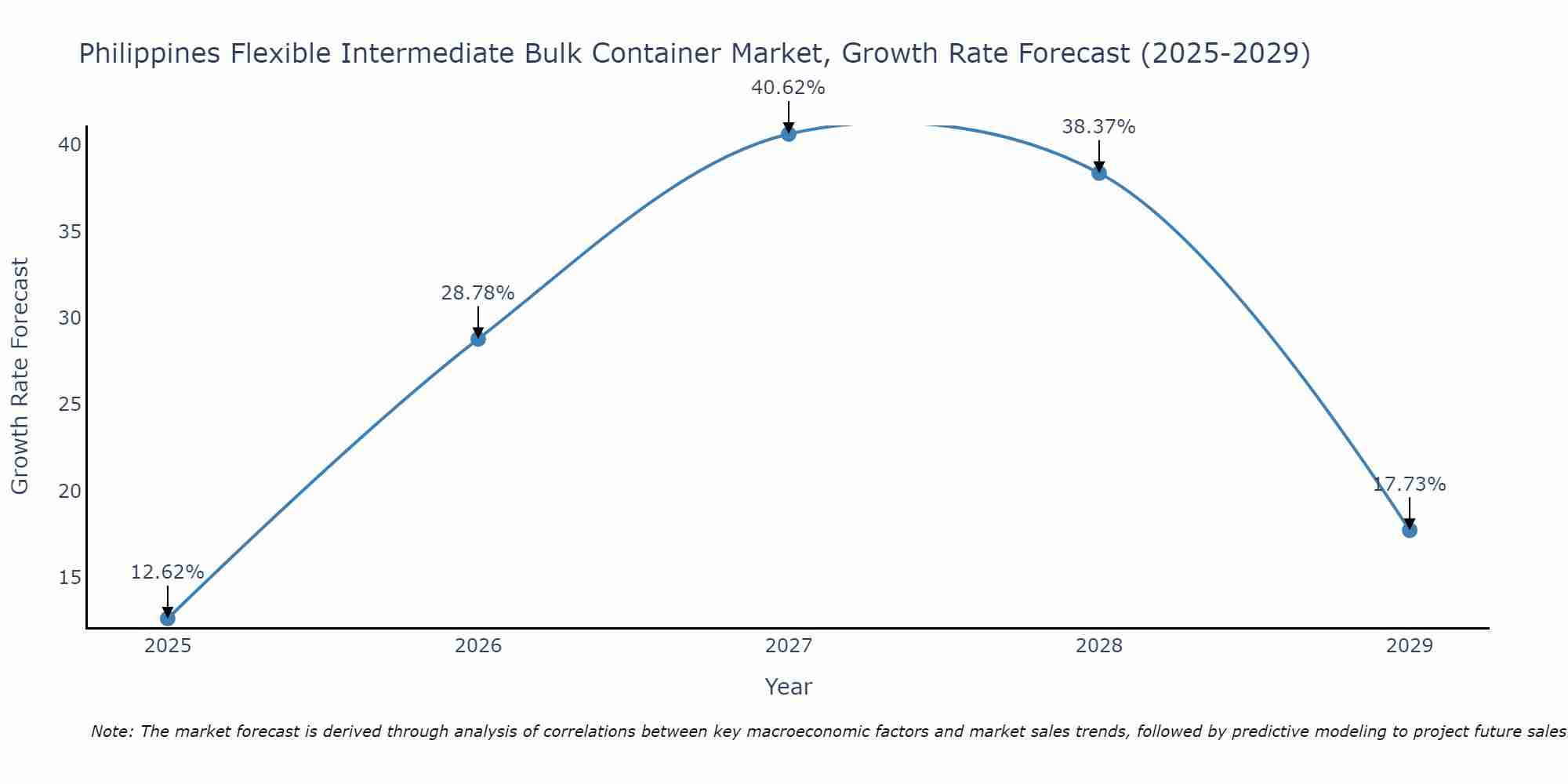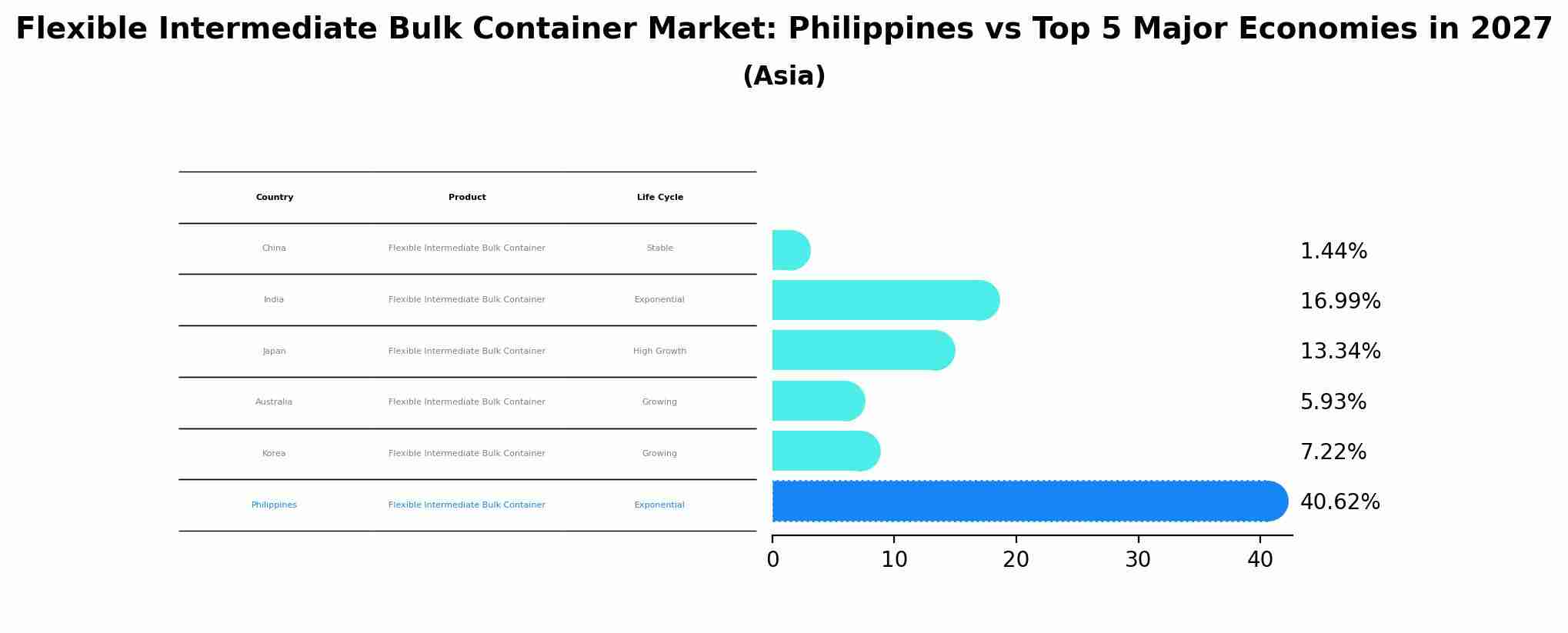Philippines Flexible Intermediate Bulk Container Market (2025-2031) Outlook | Growth, Forecast, Revenue, Trends, Analysis, Industry, Size, Companies, Value & Share
| Product Code: ETC373889 | Publication Date: Aug 2022 | Updated Date: Apr 2025 | Product Type: Market Research Report | |
| Publisher: 6Wresearch | No. of Pages: 75 | No. of Figures: 35 | No. of Tables: 20 | |
Philippines Flexible Intermediate Bulk Container Market Size Growth Rate
The Philippines Flexible Intermediate Bulk Container Market is projected to witness mixed growth rate patterns during 2025 to 2029. The growth rate begins at 12.62% in 2025, climbs to a high of 40.62% in 2027, and moderates to 17.73% by 2029.

Flexible Intermediate Bulk Container Market: Philippines vs Top 5 Major Economies in 2027 (Asia)
Philippines's Flexible Intermediate Bulk Container market is anticipated to experience a exponential growth rate of 40.62% by 2027, reflecting trends observed in the largest economy China, followed by India, Japan, Australia and South Korea.

philippines flexible intermediate bulk container market Synopsis
The flexible intermediate bulk container (FIBC) market in Philippines is anticipated to register a healthy CAGR during the forecast period due to rising prominence for cost effective packaging solutions among industries operating here. Growing economy along with development witnessed by industrial sector has fueled the demand for FIBCs in country`s manufacturing space significantly over last few years owing to its easy transportability features coupled with convenience while packing large volumes of products together conveniently without any spillage or contamination concerns making them highly popular choice amongst food & beverage industry players. Furthermore, government initiatives related to plastic waste management have also helped propel sales volume within Philippine FIBC space substantially since past couple of years which inturn associated positively towards overall revenue generated through these containers sale across country`s marketspace during forecast timeline.
Drivers of the Market
The Philippines flexible intermediate bulk container market is anticipated to experience favorable growth in the forecast period. This growth can be attributed to the expansion of industries such as agriculture, chemicals, and construction, which rely on bulk packaging solutions. FIBCs offer cost-effective and efficient storage and transportation of bulk materials, driving their demand. Moreover, the shift towards optimized supply chain management practices enhances the adoption of FIBCs in various sectors.
Challenges of the Market
In the Philippines flexible intermediate bulk container (FIBC) market, maintaining product quality and safety standards is a primary challenge. FIBCs are used for transporting bulk materials, and any compromise in their design or production can result in product leakage or even accidents. Adhering to international quality standards while ensuring cost-effectiveness can be a delicate balancing act. Moreover, as the FIBC market becomes more globalized, fluctuations in raw material prices and changing trade regulations can impact the industry`s profitability and growth potential.
COVID-19 Impact on the Market
The Philippines flexible intermediate bulk container market encountered disruptions in global supply chains, impacting the availability of raw materials and causing delays in production. With restrictions on movement, industrial activities slowed down, affecting the demand for bulk containers. Nevertheless, the gradual recovery of manufacturing and trade has contributed to a resurgence in the market.
Key Players in the Market
The flexible intermediate bulk container (FIBC) market in the Philippines is led by companies such as PQR Packaging Solutions and STU FIBCs Ltd. These key players manufacture a range of FIBCs used for the storage and transportation of bulk goods. Their containers are valued for their strength, capacity, and reliability in various industries, including agriculture, construction, and logistics. By offering customizable solutions and adhering to international safety standards, these companies have established themselves as trusted suppliers in the FIBC market.
Key Highlights of the Report:
- Philippines Flexible Intermediate Bulk Container Market Outlook
- Market Size of Philippines Flexible Intermediate Bulk Container Market, 2024
- Forecast of Philippines Flexible Intermediate Bulk Container Market, 2031
- Historical Data and Forecast of Philippines Flexible Intermediate Bulk Container Revenues & Volume for the Period 2021-2031
- Philippines Flexible Intermediate Bulk Container Market Trend Evolution
- Philippines Flexible Intermediate Bulk Container Market Drivers and Challenges
- Philippines Flexible Intermediate Bulk Container Price Trends
- Philippines Flexible Intermediate Bulk Container Porter's Five Forces
- Philippines Flexible Intermediate Bulk Container Industry Life Cycle
- Historical Data and Forecast of Philippines Flexible Intermediate Bulk Container Market Revenues & Volume By Product for the Period 2021-2031
- Historical Data and Forecast of Philippines Flexible Intermediate Bulk Container Market Revenues & Volume By Type A for the Period 2021-2031
- Historical Data and Forecast of Philippines Flexible Intermediate Bulk Container Market Revenues & Volume By Type B for the Period 2021-2031
- Historical Data and Forecast of Philippines Flexible Intermediate Bulk Container Market Revenues & Volume By Type C for the Period 2021-2031
- Historical Data and Forecast of Philippines Flexible Intermediate Bulk Container Market Revenues & Volume By Type D for the Period 2021-2031
- Historical Data and Forecast of Philippines Flexible Intermediate Bulk Container Market Revenues & Volume By End-Use for the Period 2021-2031
- Historical Data and Forecast of Philippines Flexible Intermediate Bulk Container Market Revenues & Volume By Food for the Period 2021-2031
- Historical Data and Forecast of Philippines Flexible Intermediate Bulk Container Market Revenues & Volume By Chemical for the Period 2021-2031
- Historical Data and Forecast of Philippines Flexible Intermediate Bulk Container Market Revenues & Volume By Pharmaceuticals for the Period 2021-2031
- Historical Data and Forecast of Philippines Flexible Intermediate Bulk Container Market Revenues & Volume By Others for the Period 2021-2031
- Philippines Flexible Intermediate Bulk Container Import Export Trade Statistics
- Market Opportunity Assessment By Product
- Market Opportunity Assessment By End-Use
- Philippines Flexible Intermediate Bulk Container Top Companies Market Share
- Philippines Flexible Intermediate Bulk Container Competitive Benchmarking By Technical and Operational Parameters
- Philippines Flexible Intermediate Bulk Container Company Profiles
- Philippines Flexible Intermediate Bulk Container Key Strategic Recommendations
Frequently Asked Questions About the Market Study (FAQs):
- Single User License$ 1,995
- Department License$ 2,400
- Site License$ 3,120
- Global License$ 3,795
Search
Related Reports
- ASEAN Bearings Market (2025-2031) | Strategy, Consumer Insights, Analysis, Investment Trends, Opportunities, Growth, Size, Share, Industry, Revenue, Segments, Value, Segmentation, Supply, Forecast, Restraints, Outlook, Competition, Drivers, Trends, Demand, Pricing Analysis, Competitive, Strategic Insights, Companies, Challenges
- Europe Flooring Market (2025-2031) | Outlook, Share, Industry, Trends, Forecast, Companies, Revenue, Size, Analysis, Growth & Value
- Saudi Arabia Manlift Market (2025-2031) | Outlook, Size, Growth, Trends, Companies, Industry, Revenue, Value, Share, Forecast & Analysis
- Uganda Excavator, Crane, and Wheel Loaders Market (2025-2031) | Strategy, Consumer Insights, Analysis, Investment Trends, Opportunities, Growth, Size, Share, Industry, Revenue, Segments, Value, Segmentation, Supply, Forecast, Restraints, Outlook, Competition, Drivers, Trends, Demand, Pricing Analysis, Competitive, Strategic Insights, Companies, Challenges
- Rwanda Excavator, Crane, and Wheel Loaders Market (2025-2031) | Strategy, Consumer Insights, Analysis, Investment Trends, Opportunities, Growth, Size, Share, Industry, Revenue, Segments, Value, Segmentation, Supply, Forecast, Restraints, Outlook, Competition, Drivers, Trends, Demand, Pricing Analysis, Competitive, Strategic Insights, Companies, Challenges
- Kenya Excavator, Crane, and Wheel Loaders Market (2025-2031) | Strategy, Consumer Insights, Analysis, Investment Trends, Opportunities, Growth, Size, Share, Industry, Revenue, Segments, Value, Segmentation, Supply, Forecast, Restraints, Outlook, Competition, Drivers, Trends, Demand, Pricing Analysis, Competitive, Strategic Insights, Companies, Challenges
- Angola Excavator, Crane, and Wheel Loaders Market (2025-2031) | Strategy, Consumer Insights, Analysis, Investment Trends, Opportunities, Growth, Size, Share, Industry, Revenue, Segments, Value, Segmentation, Supply, Forecast, Restraints, Outlook, Competition, Drivers, Trends, Demand, Pricing Analysis, Competitive, Strategic Insights, Companies, Challenges
- Israel Intelligent Transport System Market (2025-2031) | Strategy, Consumer Insights, Analysis, Investment Trends, Opportunities, Growth, Size, Share, Industry, Revenue, Segments, Value, Segmentation, Supply, Forecast, Restraints, Outlook, Competition, Drivers, Trends, Demand, Pricing Analysis, Competitive, Strategic Insights, Companies, Challenges
- Uganda Precast and Aggregate Market (2025-2031) | Strategy, Consumer Insights, Analysis, Investment Trends, Opportunities, Growth, Size, Share, Industry, Revenue, Segments, Value, Segmentation, Supply, Forecast, Restraints, Outlook, Competition, Drivers, Trends, Demand, Pricing Analysis, Competitive, Strategic Insights, Companies, Challenges
- Australia IT Asset Disposal Market (2025-2031) | Strategy, Consumer Insights, Analysis, Investment Trends, Opportunities, Growth, Size, Share, Industry, Revenue, Segments, Value, Segmentation, Supply, Forecast, Restraints, Outlook, Competition, Drivers, Trends, Demand, Pricing Analysis, Competitive, Strategic Insights, Companies, Challenges
Industry Events and Analyst Meet
Our Clients
Whitepaper
- Middle East & Africa Commercial Security Market Click here to view more.
- Middle East & Africa Fire Safety Systems & Equipment Market Click here to view more.
- GCC Drone Market Click here to view more.
- Middle East Lighting Fixture Market Click here to view more.
- GCC Physical & Perimeter Security Market Click here to view more.
6WResearch In News
- Doha a strategic location for EV manufacturing hub: IPA Qatar
- Demand for luxury TVs surging in the GCC, says Samsung
- Empowering Growth: The Thriving Journey of Bangladesh’s Cable Industry
- Demand for luxury TVs surging in the GCC, says Samsung
- Video call with a traditional healer? Once unthinkable, it’s now common in South Africa
- Intelligent Buildings To Smooth GCC’s Path To Net Zero













